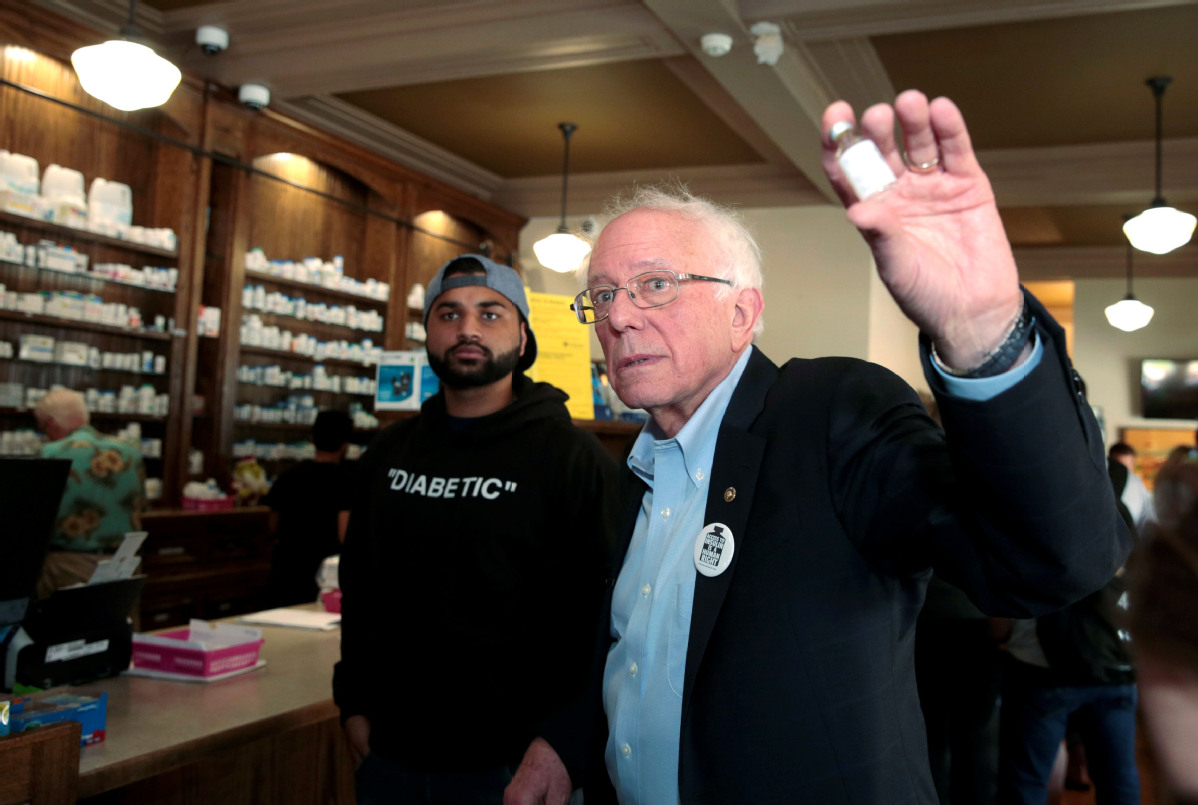Patients struggling to pay for insulin
By Lia Zhu in San Francisco | China Daily | Updated: 2019-08-12 09:24

Cost of the drug in US has skyrocketed in past decade, drawing public outcry
When US Senator Bernie Sanders took a short bus trip across the US-Canada border last month, he wasn't alone.
About a dozen people with diabetes joined the Democratic presidential candidate on the bus from Detroit, Michigan, to Windsor, Ontario, to buy insulin at a Canadian pharmacy, just minutes from the border. A vial that one woman said could set her back $340 in the United States had cost her about one-tenth of that in Windsor.
Diabetes cost US citizens more than $327 billion per year, including $15 billion for insulin, according to 2017 data from the American Diabetes Association, or ADA. The average price of an insulin prescription nearly doubled nationally from $344 in 2012 to $666 in 2016, according to the Washington-based nonprofit Health Care Cost Institute.
The soaring cost of insulin has drawn a public outcry and national scrutiny as federal and state lawmakers investigated the causes of escalating prices.
US patients without insurance or with high-deductible insurance plans pay an average of $300 per vial, while patients in Canada pay around $40 per vial - for insulin made by the same corporations, said T1International, a Minnesota nonprofit advocacy group for Type 1 diabetes patients.
Four US senators, not including Sanders, on July 22 introduced a bill that would cut insulin prices up to 75 percent.
Insulin is essential for all people with Type 1 diabetes, an autoimmune disease that occurs when a person does not produce enough insulin to enable blood sugar to enter cells for energy. Some people with Type 2 diabetes take it as well.
Without insulin, both Type 1 and Type 2 diabetes can trigger complications such as blindness and kidney failure, and lead to stroke and death, according to WHO.
Diabetes is the seventh-most-common cause of death and the most expensive chronic disease in the US, according to ADA. More than 30 million people in the US have diabetes, and approximately 7.4 million of them rely on insulin, according to the diabetes association.
However, the drug has become so costly that large numbers of people are going without it or rationing their doses, according to a Yale University study and T1International.
An ADA study group last year concluded that a complex supply chain from the drug factory to the pharmacy creates incentives to artificially raise the price.
Lack of competition
Pricing of insulin involves numerous stakeholders, including manufacturers, wholesalers, pharmacies and pharmacy benefit managers, or PBMs - intermediaries between manufacturers and health insurers.
Insurers do not pay the list prices that the drugmakers set. Instead, the PBMs negotiate a rebate that is returned to them. The PBMs, in return, take a slice of that rebate for themselves.
As a result, the price ultimately paid by the person with diabetes is a combination of the list prices, rebates and fees negotiated among the stakeholders.
When the list price goes up, the profits of the intermediaries in the supply chain increase, but patients may find their out-of-pocket costs rise even if they have health insurance.
Insulin prices aren't only a US problem. The lack of competition causes higher prices in the global insulin market, which is dominated by three major insulin manufacturers: Eli Lilly in the US, Novo Nordisk in Denmark and Sanofi in France. Currently, there are only two generic versions of insulin for sale in the US, which are slightly cheaper than the original.
Diabetes rates have risen steadily over the past three decades, from affecting around 5 percent of adults around the world in 1980 to roughly 9 percent today.
The insulin required to treat Type 2 diabetes is expected to increase by more than 20 percent worldwide from 2018 to 2030, according to Stanford Health Policy, a research group associated with Stanford University's medical school.
Without major improvements in cost and access, about half of the 79 million adults with Type 2 diabetes in the world won't get the lifesaving drug, according to the research.
In April, executives from the three insulin manufacturers and three major PBMs testified before Congress.
The drugmakers said they could not reduce list prices because the PBMs and insurance companies demand discounts, rebates and other price concessions that are calculated as a percentage of the list price. The PBMs said premiums would go up if they no longer received rebate payments.
Following Senate and House hearings this year, Eli Lilly rolled out a cheaper version of Humalog after it was shown that the price of a vial of the drug had increased from $35 in 2001 to $234 in 2015.
The only way drug prices will be reduced is through a price war with a competitor or by attracting the attention of lawmakers and regulators through "public outrage and corporate shaming", Andrew Friedson, a healthcare economist at the University of Colorado Denver, told the Los Angeles Times in April.
























